check transmission fluid JEEP COMMANDER 2009 1.G Owners Manual
[x] Cancel search | Manufacturer: JEEP, Model Year: 2009, Model line: COMMANDER, Model: JEEP COMMANDER 2009 1.GPages: 519, PDF Size: 9.78 MB
Page 205 of 519
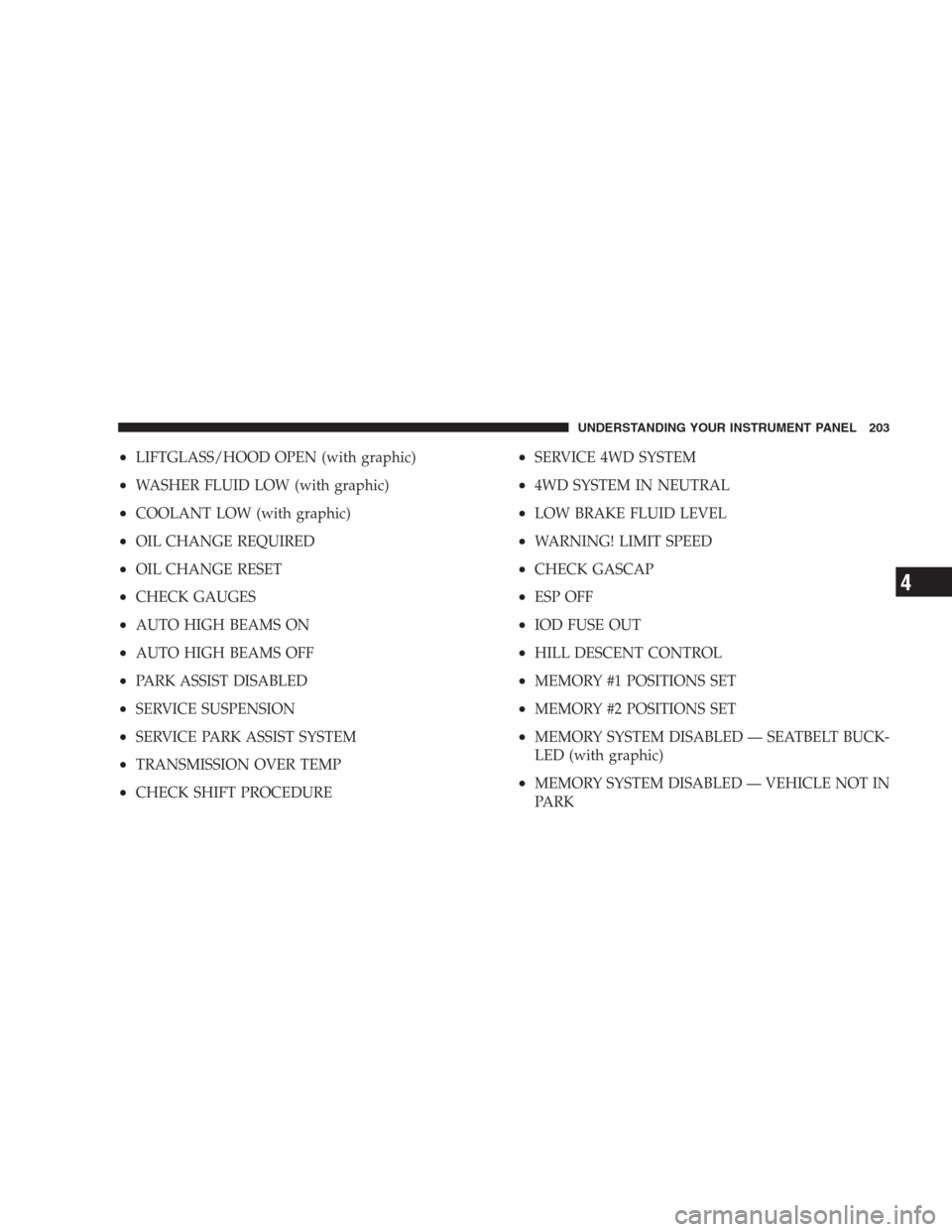
•LIFTGLASS/HOOD OPEN (with graphic)
•WASHER FLUID LOW (with graphic)
•COOLANT LOW (with graphic)
•OIL CHANGE REQUIRED
•OIL CHANGE RESET
•CHECK GAUGES
•AUTO HIGH BEAMS ON
•AUTO HIGH BEAMS OFF
•PARK ASSIST DISABLED
•SERVICE SUSPENSION
•SERVICE PARK ASSIST SYSTEM
•TRANSMISSION OVER TEMP
•CHECK SHIFT PROCEDURE
•SERVICE 4WD SYSTEM
•4WD SYSTEM IN NEUTRAL
•LOW BRAKE FLUID LEVEL
•WARNING! LIMIT SPEED
•CHECK GASCAP
•ESP OFF
•IOD FUSE OUT
•HILL DESCENT CONTROL
•MEMORY #1 POSITIONS SET
•MEMORY #2 POSITIONS SET
•MEMORY SYSTEM DISABLED — SEATBELT BUCK-
LED (with graphic)
•MEMORY SYSTEM DISABLED — VEHICLE NOT IN
PARK
UNDERSTANDING YOUR INSTRUMENT PANEL 203
4
Page 320 of 519
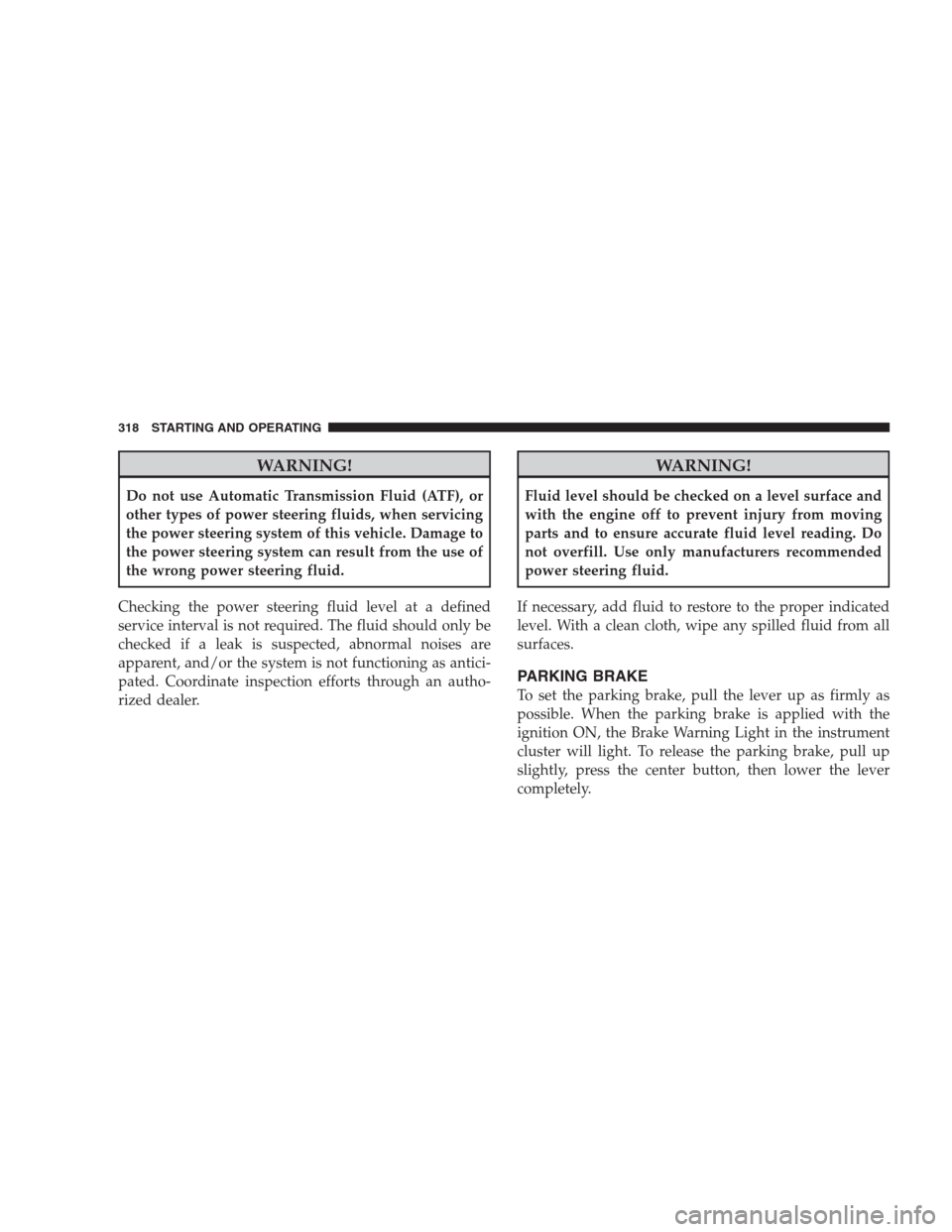
WARNING!
Do not use Automatic Transmission Fluid (ATF), or
other types of power steering fluids, when servicing
the power steering system of this vehicle. Damage to
the power steering system can result from the use of
the wrong power steering fluid.
Checking the power steering fluid level at a defined
service interval is not required. The fluid should only be
checked if a leak is suspected, abnormal noises are
apparent, and/or the system is not functioning as antici-
pated. Coordinate inspection efforts through an autho-
rized dealer.
WARNING!
Fluid level should be checked on a level surface and
with the engine off to prevent injury from moving
parts and to ensure accurate fluid level reading. Do
not overfill. Use only manufacturers recommended
power steering fluid.
If necessary, add fluid to restore to the proper indicated
level. With a clean cloth, wipe any spilled fluid from all
surfaces.
PARKING BRAKE
To set the parking brake, pull the lever up as firmly as
possible. When the parking brake is applied with the
ignition ON, the Brake Warning Light in the instrument
cluster will light. To release the parking brake, pull up
slightly, press the center button, then lower the lever
completely.
318 STARTING AND OPERATING
Page 393 of 519
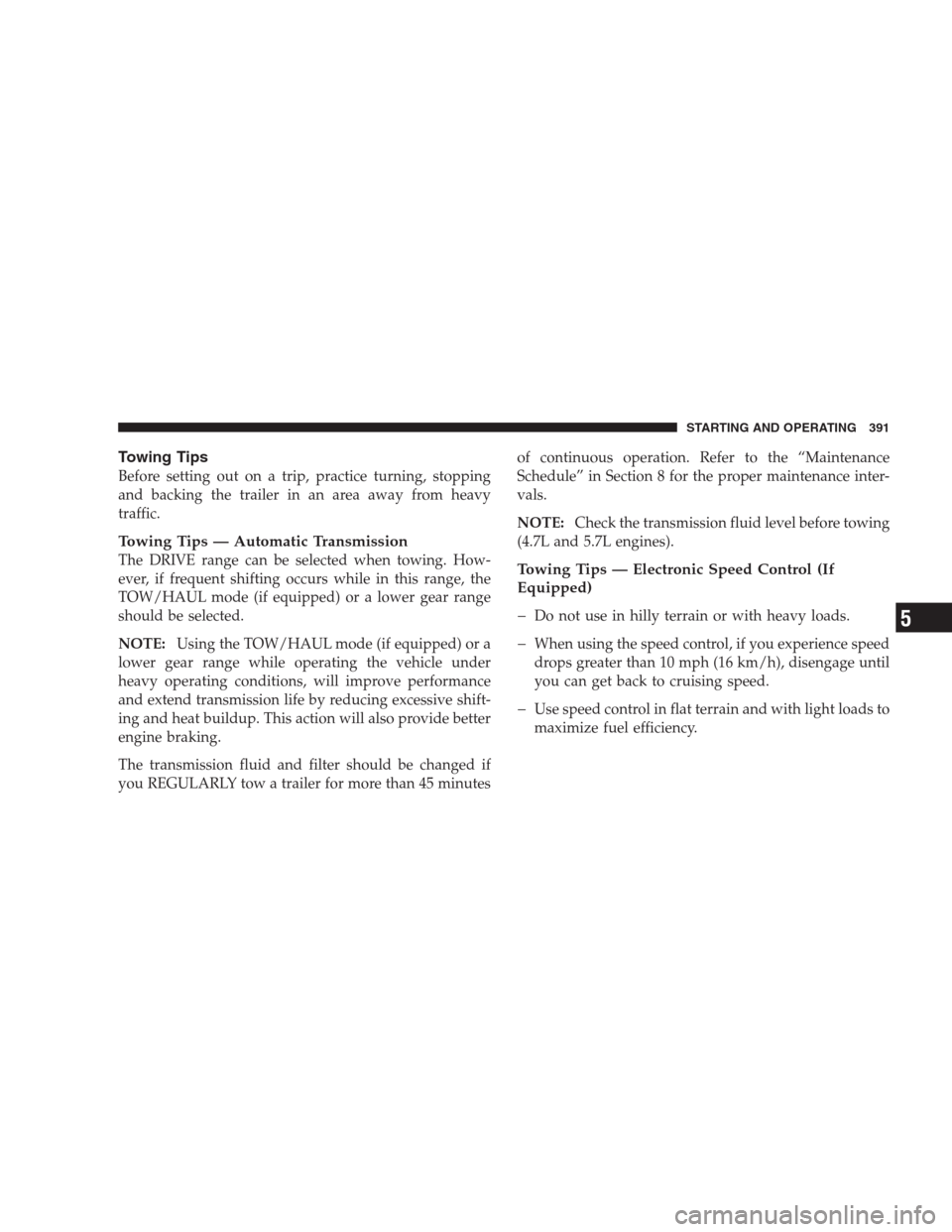
Towing Tips
Before setting out on a trip, practice turning, stopping
and backing the trailer in an area away from heavy
traffic.
Towing Tips — Automatic Transmission
The DRIVE range can be selected when towing. How-
ever, if frequent shifting occurs while in this range, the
TOW/HAUL mode (if equipped) or a lower gear range
should be selected.
NOTE:Using the TOW/HAUL mode (if equipped) or a
lower gear range while operating the vehicle under
heavy operating conditions, will improve performance
and extend transmission life by reducing excessive shift-
ing and heat buildup. This action will also provide better
engine braking.
The transmission fluid and filter should be changed if
you REGULARLY tow a trailer for more than 45 minutesof continuous operation. Refer to the “Maintenance
Schedule” in Section 8 for the proper maintenance inter-
vals.
NOTE:Check the transmission fluid level before towing
(4.7L and 5.7L engines).Towing Tips — Electronic Speed Control (If
Equipped)
�
Do not use in hilly terrain or with heavy loads.
�When using the speed control, if you experience speed
drops greater than 10 mph (16 km/h), disengage until
you can get back to cruising speed.
�Use speed control in flat terrain and with light loads to
maximize fuel efficiency.
STARTING AND OPERATING 391
5
Page 443 of 519
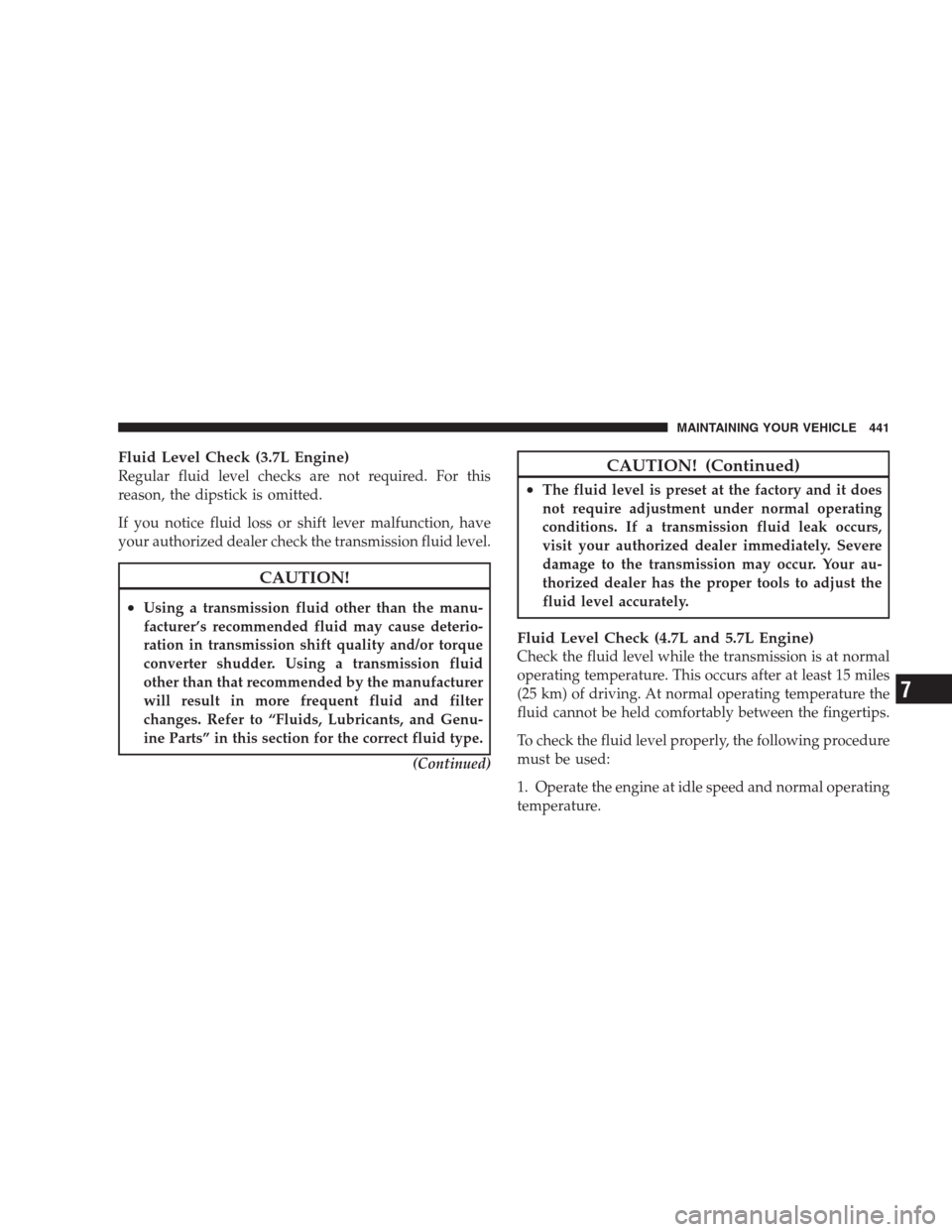
Fluid Level Check (3.7L Engine)
Regular fluid level checks are not required. For this
reason, the dipstick is omitted.
If you notice fluid loss or shift lever malfunction, have
your authorized dealer check the transmission fluid level.
CAUTION!
•Using a transmission fluid other than the manu-
facturer’s recommended fluid may cause deterio-
ration in transmission shift quality and/or torque
converter shudder. Using a transmission fluid
other than that recommended by the manufacturer
will result in more frequent fluid and filter
changes. Refer to “Fluids, Lubricants, and Genu-
ine Parts” in this section for the correct fluid type.
(Continued)
CAUTION! (Continued)
•The fluid level is preset at the factory and it does
not require adjustment under normal operating
conditions. If a transmission fluid leak occurs,
visit your authorized dealer immediately. Severe
damage to the transmission may occur. Your au-
thorized dealer has the proper tools to adjust the
fluid level accurately.
Fluid Level Check (4.7L and 5.7L Engine)
Check the fluid level while the transmission is at normal
operating temperature. This occurs after at least 15 miles
(25 km) of driving. At normal operating temperature the
fluid cannot be held comfortably between the fingertips.
To check the fluid level properly, the following procedure
must be used:
1. Operate the engine at idle speed and normal operating
temperature.
MAINTAINING YOUR VEHICLE 441
7
Page 444 of 519
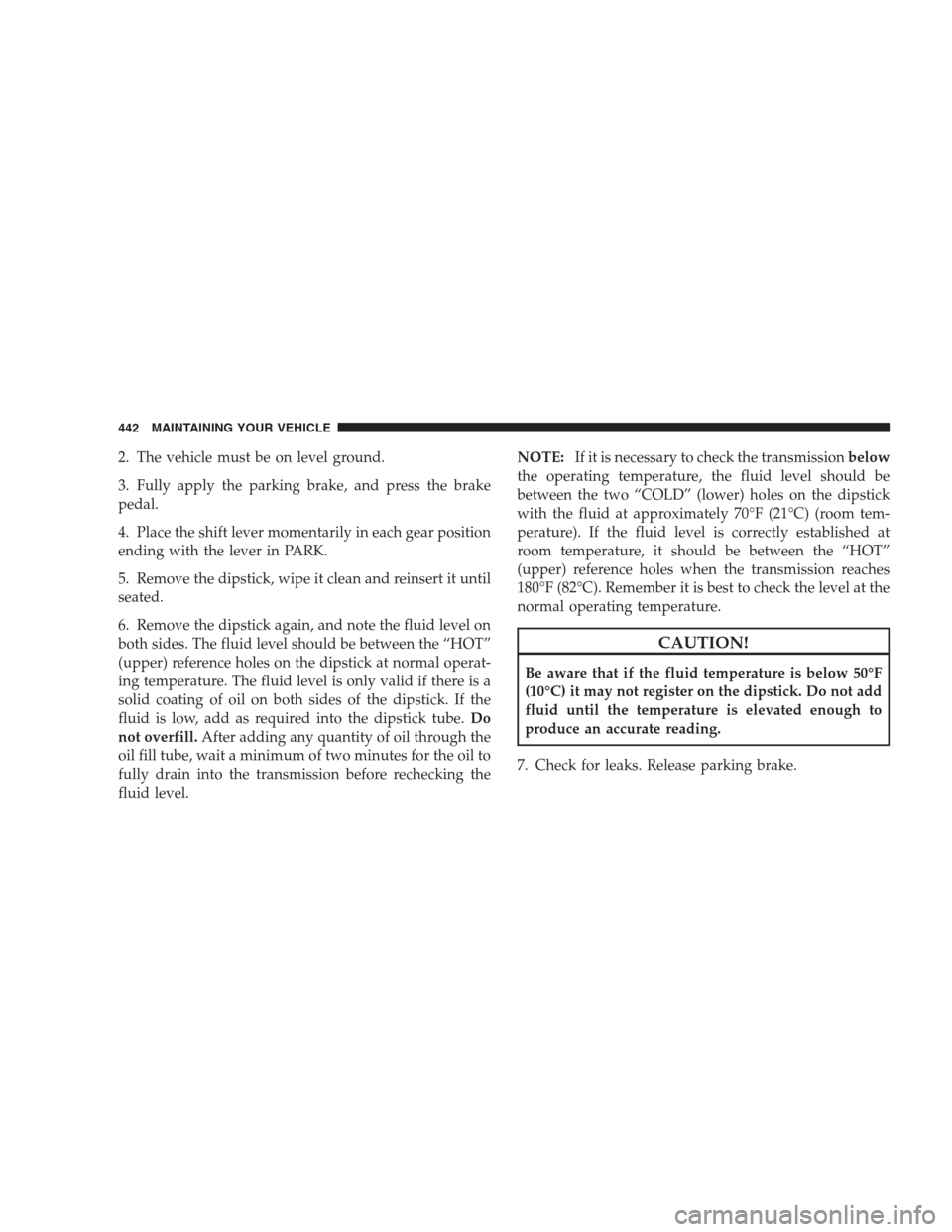
2. The vehicle must be on level ground.
3. Fully apply the parking brake, and press the brake
pedal.
4. Place the shift lever momentarily in each gear position
ending with the lever in PARK.
5. Remove the dipstick, wipe it clean and reinsert it until
seated.
6. Remove the dipstick again, and note the fluid level on
both sides. The fluid level should be between the “HOT”
(upper) reference holes on the dipstick at normal operat-
ing temperature. The fluid level is only valid if there is a
solid coating of oil on both sides of the dipstick. If the
fluid is low, add as required into the dipstick tube.Do
not overfill.After adding any quantity of oil through the
oil fill tube, wait a minimum of two minutes for the oil to
fully drain into the transmission before rechecking the
fluid level.NOTE:If it is necessary to check the transmissionbelow
the operating temperature, the fluid level should be
between the two “COLD” (lower) holes on the dipstick
with the fluid at approximately 70°F (21°C) (room tem-
perature). If the fluid level is correctly established at
room temperature, it should be between the “HOT”
(upper) reference holes when the transmission reaches
180°F (82°C). Remember it is best to check the level at the
normal operating temperature.
CAUTION!
Be aware that if the fluid temperature is below 50°F
(10°C) it may not register on the dipstick. Do not add
fluid until the temperature is elevated enough to
produce an accurate reading.
7. Check for leaks. Release parking brake.
442 MAINTAINING YOUR VEHICLE
Page 445 of 519
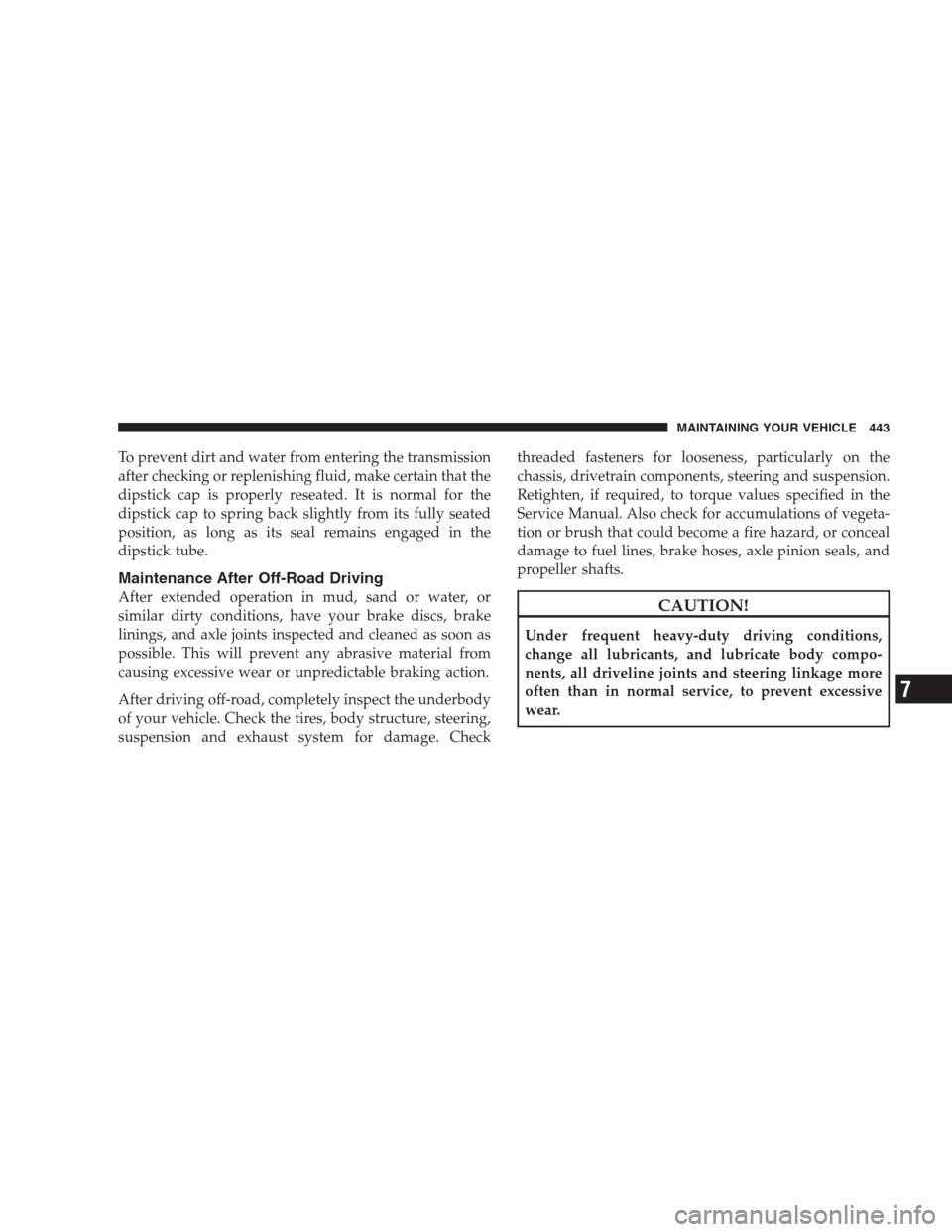
To prevent dirt and water from entering the transmission
after checking or replenishing fluid, make certain that the
dipstick cap is properly reseated. It is normal for the
dipstick cap to spring back slightly from its fully seated
position, as long as its seal remains engaged in the
dipstick tube.
Maintenance After Off-Road Driving
After extended operation in mud, sand or water, or
similar dirty conditions, have your brake discs, brake
linings, and axle joints inspected and cleaned as soon as
possible. This will prevent any abrasive material from
causing excessive wear or unpredictable braking action.
After driving off-road, completely inspect the underbody
of your vehicle. Check the tires, body structure, steering,
suspension and exhaust system for damage. Checkthreaded fasteners for looseness, particularly on the
chassis, drivetrain components, steering and suspension.
Retighten, if required, to torque values specified in the
Service Manual. Also check for accumulations of vegeta-
tion or brush that could become a fire hazard, or conceal
damage to fuel lines, brake hoses, axle pinion seals, and
propeller shafts.CAUTION!
Under frequent heavy-duty driving conditions,
change all lubricants, and lubricate body compo-
nents, all driveline joints and steering linkage more
often than in normal service, to prevent excessive
wear.
MAINTAINING YOUR VEHICLE 443
7
Page 473 of 519

•Change your engine oil more often if you drive your
vehicle off-road for an extended period of time.
•Under no circumstances should oil change intervals
exceed 6,000 miles (10,000 km) or 6 months, whichever
comes first.
Your authorized dealer will reset the oil change indicator
message after completing the scheduled oil change. If this
scheduled oil change is performed by someone other
than your authorized dealer the message can be reset by
referring to the steps described under ”Electronic Vehicle
Information Center” in Section 4 of this manual.
At Each Stop for Fuel
•Check the engine oil level about 5 minutes after a fully
warmed engine is shut off. Checking the oil level while
the vehicle is on level ground will improve the accu-
racy of the oil level reading. Add oil only when the
level is at or below the ADD or MIN mark.
•Check the windshield washer solvent and add if
required.
Once a Month
•Check tire pressure and look for unusual wear or
damage.
•Inspect the battery and clean and tighten the terminals
as required.
•Check the fluid levels of coolant reservoir, brake
master cylinder, power steering and transmission
(4.7L and 5.7L engines) and add as needed.
•Check all lights and other electrical items for correct
operation.
At Each Oil Change
•Change the engine oil filter.
•Inspect the brake hoses and lines.
MAINTENANCE SCHEDULES 471
8
M
A
I
N
T
E
N
A
N
C
E
S
C
H
E
D
U
L
E
S
Page 498 of 519
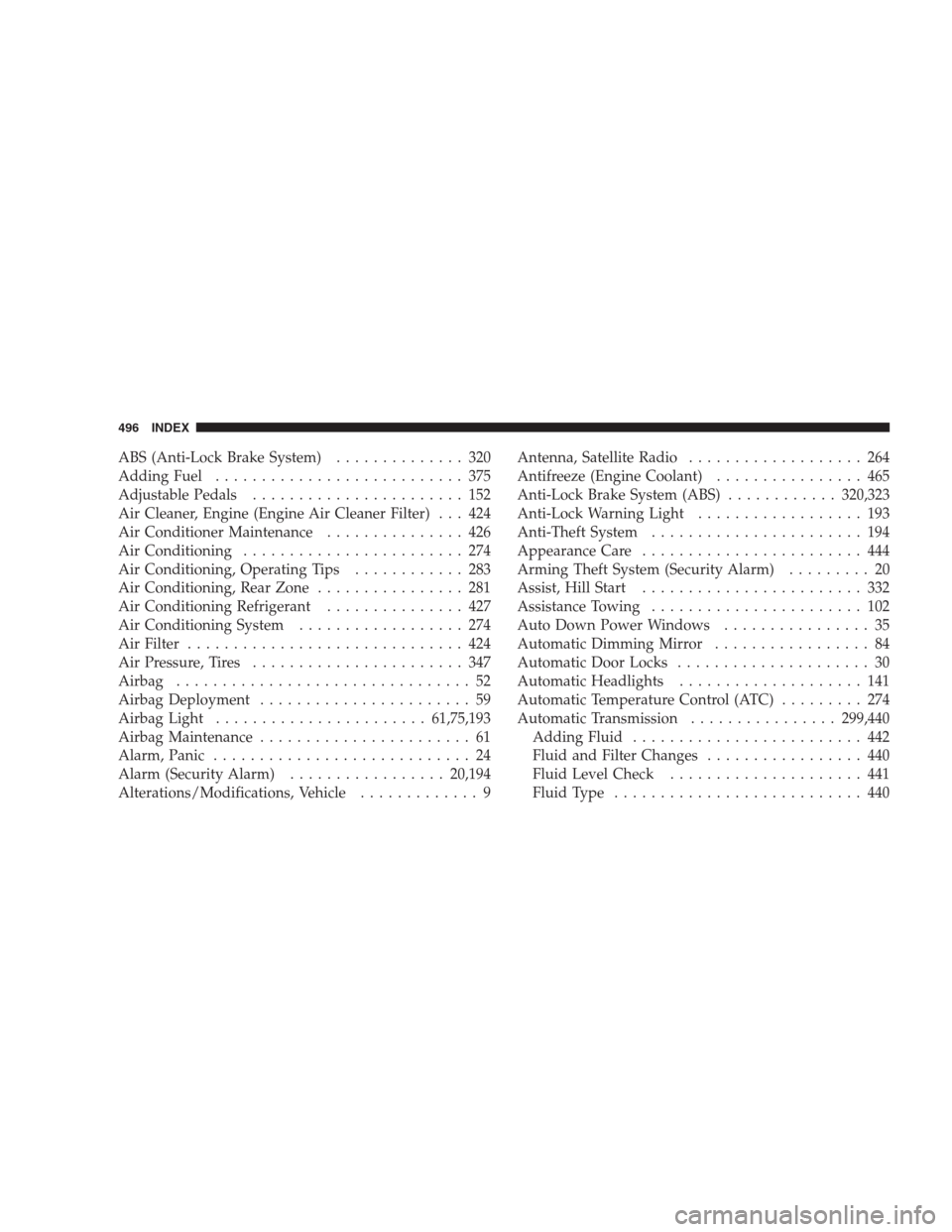
ABS (Anti-Lock Brake System).............. 320
Adding Fuel........................... 375
Adjustable Pedals....................... 152
Air Cleaner, Engine (Engine Air Cleaner Filter) . . . 424
Air Conditioner Maintenance............... 426
Air Conditioning........................ 274
Air Conditioning, Operating Tips............ 283
Air Conditioning, Rear Zone................ 281
Air Conditioning Refrigerant............... 427
Air Conditioning System.................. 274
Air Filter.............................. 424
Air Pressure, Tires....................... 347
Airbag................................ 52
Airbag Deployment....................... 59
Airbag Light.......................61,75,193
Airbag Maintenance....................... 61
Alarm, Panic............................ 24
Alarm (Security Alarm).................20,194
Alterations/Modifications, Vehicle............. 9Antenna, Satellite Radio................... 264
Antifreeze (Engine Coolant)................ 465
Anti-Lock Brake System (ABS)............320,323
Anti-Lock Warning Light.................. 193
Anti-Theft System....................... 194
Appearance Care........................ 444
Arming Theft System (Security Alarm)......... 20
Assist, Hill Start........................ 332
Assistance Towing....................... 102
Auto Down Power Windows................ 35
Automatic Dimming Mirror................. 84
Automatic Door Locks..................... 30
Automatic Headlights.................... 141
Automatic Temperature Control (ATC)......... 274
Automatic Transmission................299,440
Adding Fluid......................... 442
Fluid and Filter Changes................. 440
Fluid Level Check..................... 441
Fluid Type........................... 440
496 INDEX
Page 499 of 519
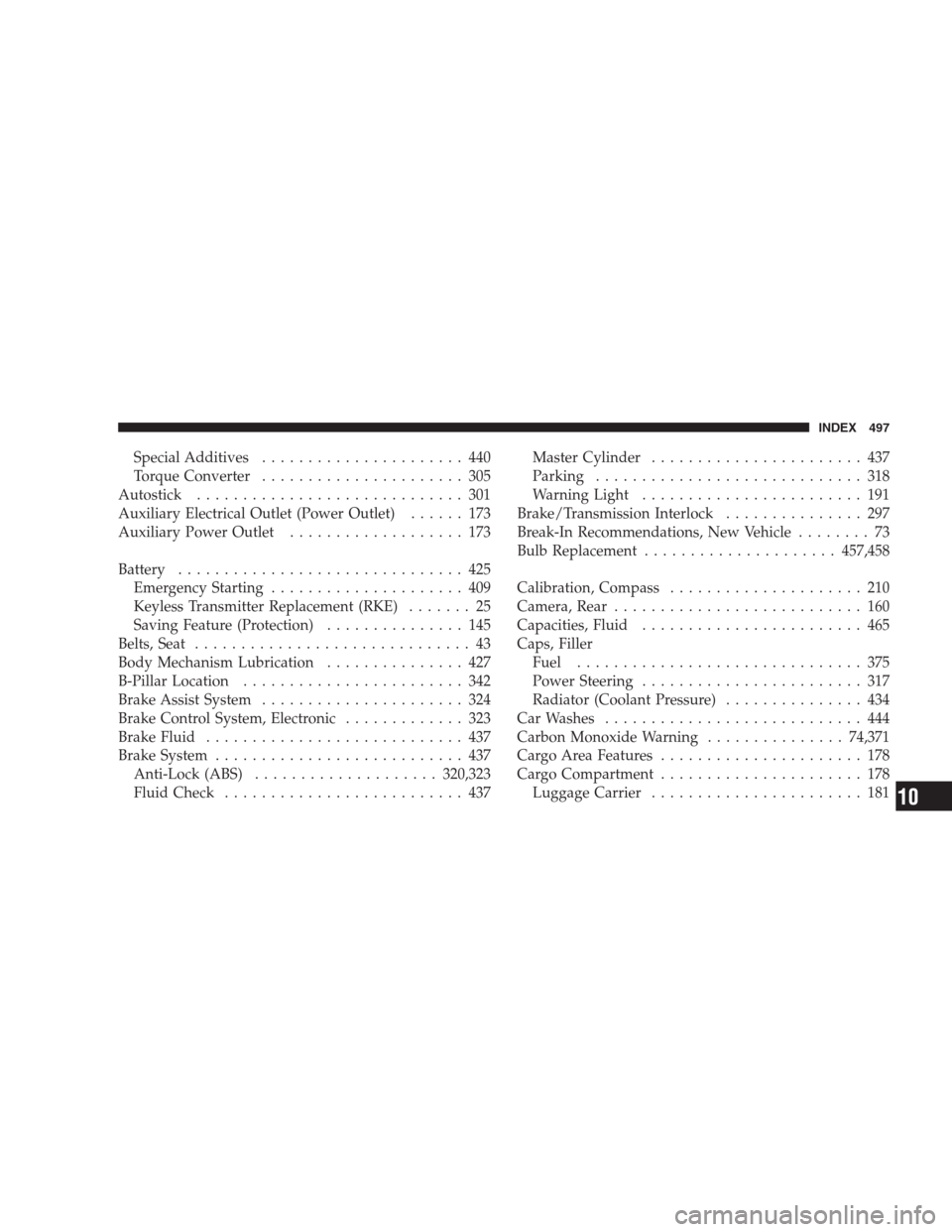
Special Additives...................... 440
Torque Converter...................... 305
Autostick............................. 301
Auxiliary Electrical Outlet (Power Outlet)...... 173
Auxiliary Power Outlet................... 173
Battery............................... 425
Emergency Starting..................... 409
Keyless Transmitter Replacement (RKE)....... 25
Saving Feature (Protection)............... 145
Belts, Seat.............................. 43
Body Mechanism Lubrication............... 427
B-Pillar Location........................ 342
Brake Assist System...................... 324
Brake Control System, Electronic............. 323
Brake Fluid............................ 437
Brake System........................... 437
Anti-Lock (ABS)....................320,323
Fluid Check.......................... 437Master Cylinder....................... 437
Parking............................. 318
Warning Light........................ 191
Brake/Transmission Interlock............... 297
Break-In Recommendations, New Vehicle........ 73
Bulb Replacement.....................457,458
Calibration, Compass..................... 210
Camera, Rear........................... 160
Capacities, Fluid........................ 465
Caps, Filler
Fuel............................... 375
Power Steering........................ 317
Radiator (Coolant Pressure)............... 434
Car Washes............................ 444
Carbon Monoxide Warning...............74,371
Cargo Area Features...................... 178
Cargo Compartment...................... 178
Luggage Carrier....................... 181
INDEX 497
10
Page 503 of 519
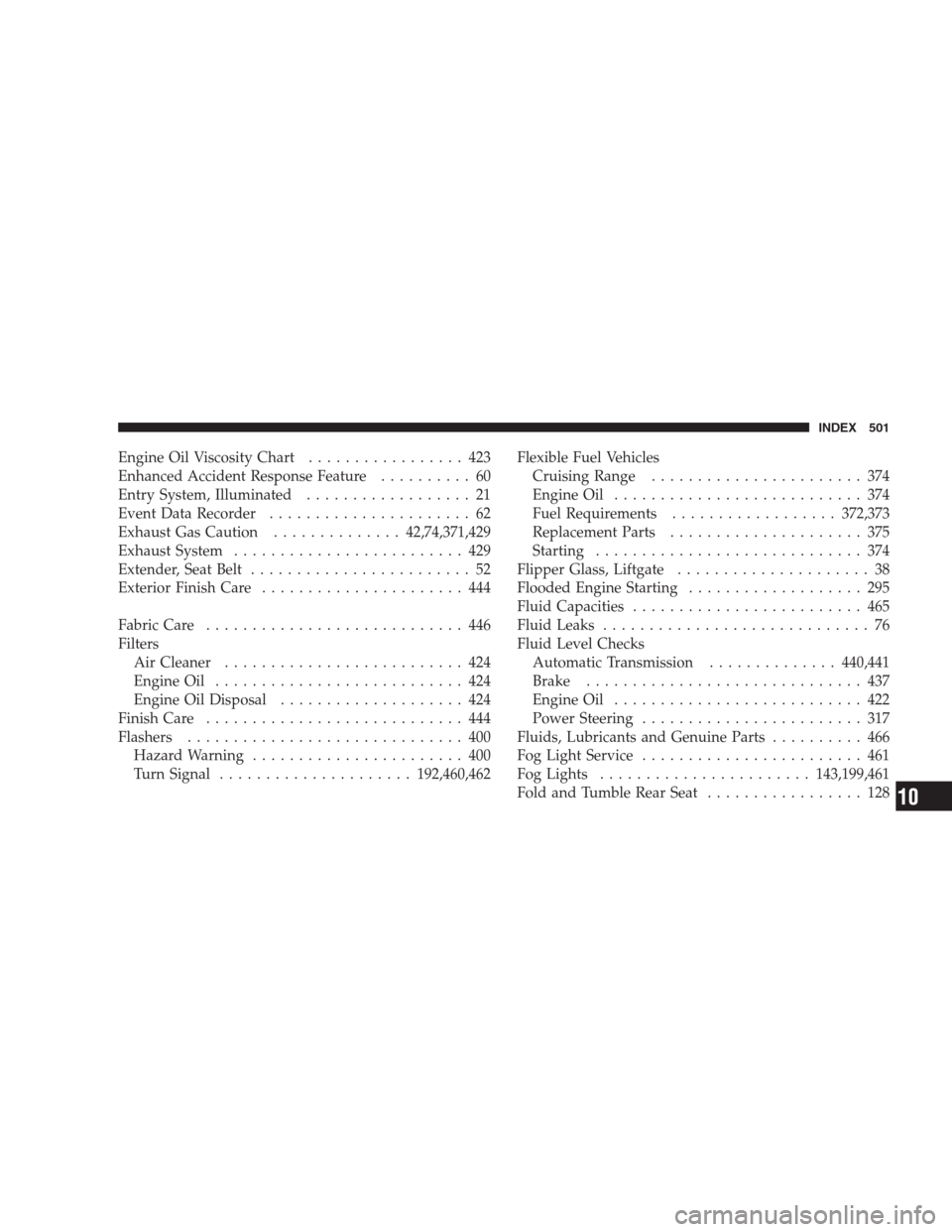
Engine Oil Viscosity Chart................. 423
Enhanced Accident Response Feature.......... 60
Entry System, Illuminated.................. 21
Event Data Recorder...................... 62
Exhaust Gas Caution..............42,74,371,429
Exhaust System......................... 429
Extender, Seat Belt........................ 52
Exterior Finish Care...................... 444
Fabric Care............................ 446
Filters
Air Cleaner.......................... 424
Engine Oil........................... 424
Engine Oil Disposal.................... 424
Finish Care............................ 444
Flashers.............................. 400
Hazard Warning....................... 400
Turn Signal.....................192,460,462Flexible Fuel Vehicles
Cruising Range....................... 374
Engine Oil........................... 374
Fuel Requirements..................372,373
Replacement Parts..................... 375
Starting............................. 374
Flipper Glass, Liftgate..................... 38
Flooded Engine Starting................... 295
Fluid Capacities......................... 465
Fluid Leaks............................. 76
Fluid Level Checks
Automatic Transmission..............440,441
Brake.............................. 437
Engine Oil........................... 422
Power Steering........................ 317
Fluids, Lubricants and Genuine Parts.......... 466
Fog Light Service........................ 461
Fog Lights.......................143,199,461
Fold and Tumble Rear Seat................. 128
INDEX 501
10